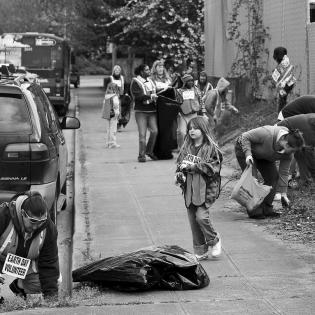Repair, Reuse, Recycle (Private-Religious)
This lesson guides students to recognize the importance of taking care of the world by reducing trash. Students will recognize the benefits of recycling and reusing.
The learner will:
- explain how Joseph, in Joseph Had a Little Overcoat, didn’t let his clothing go to waste.
- recognize the benefits to the environmentby repairing, reusing, and recycling rather than throwing things away.
- demonstrate creativity in reusing old objects by turning them into new objects.
- Apple slices for a snack
- Student copies of Attachment One: I Care for the Environment
- Materials for setting up a recycle station at school
- Read-aloud copy of Joseph Had a Little Overcoat by Simms Taback
The students find objects at home that are considered trash, and use them to make an art project.The students bring their art projects to school and share them with the class.
Taback, Simms. Joseph Had A Little Overcoat. Viking, 1999. ISBN: 0670878553
Instructions
Day One:
Anticipatory Set: Hand out apple slices for students to eat.Ask students where we get apples.Talk about the process of seeds, germination, and the development of the tree which eventually produces fruit, building an awareness of the energy, time, and miracle behind the fruit. Lead the students to recognize that trees are a special part of our natural world that deserve our appreciation and care.Wouldn’t it be sad and wasteful to cut down a tree carelessly?
Teach the concept of Ba’al Tashchit, which means “do not destroy.”Tell how Judaism teaches that we should not waste. For example:You may not throw away good food. You should not break an object for no reason.
Introduce the story Joseph Had a Little Overcoat, explaining that it is about a man named Joseph who doesn’t let things go to waste.Read the book aloud. (In the book, Joseph recycles his overcoat numerous times until it is nothing but a button.)
Ask the students to recall what Joseph did when his coat got old and shabby.Recall as a group the progression from coat to button.Ask the students why they think he didn’t just throw the coat away and buy or sew a new one.
Ask the students if this is what they do when their clothes wear out (or when they grow out of them). Discuss their answers.Discuss how they could use other common items in creative ways rather than throwing them away.
Have the students complete Attachment One: I Care for the Environment, telling how they might reuse the items listed.Younger students may complete just one page. Encourage students to think creatively.
Day Two
Allow some time for the students to share their creative ideas (Attachment One: I Care for the Environment) with the class.Tell the class that their creative ideas will reduce the amount of garbage they produce.
Raise awareness of the importance of recycling by discussing the problems with garbage.For example: Garbage is brought to a dump where it is buried and covered with dirt to decompose over many years.The problem is that some things never decompose and we are running out of room to bury garbage.Some garbage is burned, but fumes from garbage can be harmful to plants, animals and people.
Lead the students to state that reducing our consumption, reusing items, and recycling are ways to take care of the Earth.
Tell the students what happens with the materials they recycle.
Examples:Paper – newspapers, cardboard containers, wrapping paper, greeting cardsCardboard – picture frames, pens, boxes, puzzlesPlastic – shoes, clothing, soda bottlesSteel – cans, bikes, refrigeratorsGlass – glass jars, dishes, tiles, beads
Tell the students that they are going to start a recycling center at school for paper, plastic, and metal. (Contact a local recycle center to obtain guidelines.) Work with the students to provide labeled recycling boxes (for paper, plastic, and metal) in appropriate places around school.They can come up with ideas to communicate expectations to the other students. Help the students manage the project and bring the recycled goods to a local recycling station. This may continue over the entire school year.
If recycling containers already exist in the school, the students can create posters, and/or perform simple songs or skits to raise awareness of those items that can be recycled and the importance of using the recycling containers.
Assessment will be based upon the students’ participation in class—their questions, answers and comments, as well as their performance on the worksheet.
Students provide labeled recycling boxes (for paper, plastic, and metal) in appropriate places around school.They communicate expectations, manage the project, and bring the recycled goods to a local recycling station. Students provide labeled recycling boxes (for paper, plastic, and metal) in appropriate places around school.They communicate expectations, manage the project, and bring the recycled goods to a local recycling station.
Handouts
Philanthropy Framework
-
Strand PHIL.II Philanthropy and Civil Society
-
Standard PCS 03. Philanthropy and Economics
-
Benchmark E.13 Describe limited resources and scarcity.
-
-
-
Strand PHIL.III Philanthropy and the Individual
-
Standard PI 01. Reasons for Individual Philanthropy
-
Benchmark E.3 Define stewardship and give examples.
-
-
